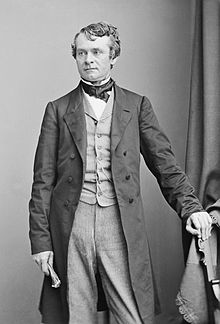Andrew Gregg Curtin
| Andrew Gregg Curtin | |
|---|---|
 |
|
| 15th Governor of Pennsylvania | |
|
In office January 15, 1861 – January 15, 1867 |
|
| Preceded by | William Packer |
| Succeeded by | John Geary |
| Member of the U.S. House of Representatives from Pennsylvania's 20th district |
|
|
In office March 4, 1881 – March 3, 1887 |
|
| Preceded by | Seth Yocum |
| Succeeded by | John Patton |
| United States Ambassador to Russia | |
|
In office October 28, 1869 – July 1, 1872 |
|
| President | Ulysses S. Grant |
| Preceded by | Cassius M. Clay |
| Succeeded by | James Orr |
| Personal details | |
| Born |
April 22, 1817 Bellefonte, Pennsylvania, U.S. |
| Died | October 7, 1894 (aged 77) Bellefonte, Pennsylvania, U.S. |
| Political party | Whig, Republican, Democratic, |
| Profession | Politician, Lawyer |
| Religion | Presbyterian |
Andrew Gregg Curtin (April 22, 1817 – October 7, 1894) was a U.S. lawyer and politician. He served as the Governor of Pennsylvania during the Civil War.
Curtin was born in Bellefonte, Pennsylvania. His parents were Roland Curtin, Sr., a wealthy Irish-born iron manufacturer from County Clare, and Jane (Gregg) Curtin, the daughter of U.S. Senator Andrew Gregg. His father, with Miles Boggs, established the Eagle Ironworks at Curtin Village in 1810. He attended Bellefonte Academy and Dickinson College and the Dickinson School of Law and was employed as a lawyer. Curtin first entered politics in the 1840 election, where he campaigned for Whig presidential candidate William Henry Harrison. In 1855, Governor James Pollock appointed him as Superintendent of Public Schools. With the collapse of the Whigs, Curtin switched to the newly formed Republican Party and successfully ran for governor of Pennsylvania in 1860. Curtin won re-election to the office in 1863. In the 1860 presidential election, Curtin helped Abraham Lincoln win the Republican nomination.
...
Wikipedia
